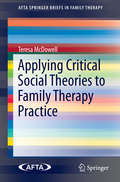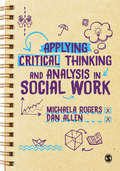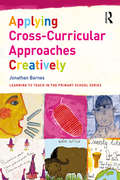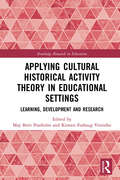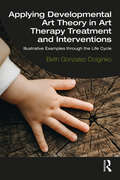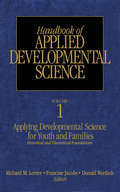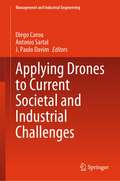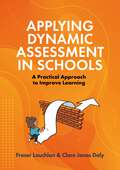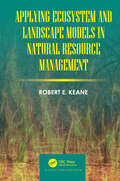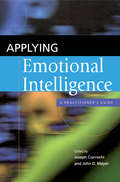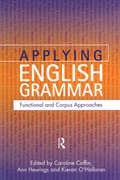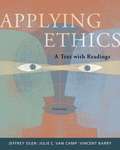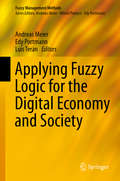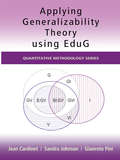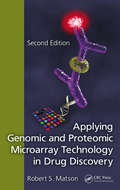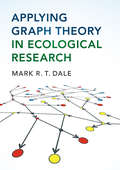- Table View
- List View
Applying Critical Evaluation: Making an Impact in Small Business (Making an Impact in Small Business HR)
by Jennifer CurrenceHR professionals are constantly asked to make sound decisions with limited time and resources. Applying Critical Evaluation offers practical, ready-to-use guidance to help HR practitioners - especially in small businesses or departments of one - think strategically and drive better outcomes. Drawing from thought leadership and real-world examples, the book walks through every stage of the evaluation process, from gathering and interpreting data to proposing solutions and influencing decisions. Tools, worksheets and case studies support immediate implementation across a range of HR functions, from selecting an HRIS and identifying training programs to developing an onboarding process or proposing organizational restructuring. Whether you're refining an existing process or building one from scratch, this book is a trusted guide to becoming a more effective, analytical HR professional.
Applying Critical Social Theories to Family Therapy Practice (AFTA SpringerBriefs in Family Therapy #0)
by Teresa McdowellThis volume applies critical social theories to family therapy practice, using sociopolitical context for a clearer focus on the power dynamics of couple and family relationships. Its decolonizing approach to therapy is shown countering the pervasive cultural themes that grant privilege to specific groups over others, feeding unequal and oppressive relationships that bring families and couples to treatment. Therapy is shown here as a layered and nuanced process, with practitioners developing an ethical human rights perspective toward their work as they aid clients in negotiating for greater justice and equity in their relationships. The book bridges theory and practice by giving readers these essential tools: Strategies for asking clients about social class. A framework for understanding gender issues within the larger patriarchy. Guidelines for relating concepts of race and class in therapy. Structure for creating the family cartography. Ways to utilize a queer perspective in therapy. Illustrative case examples throughout. Breaking new ground in family therapy, Applying Critical Social Theories to Family Therapy Practice challenges social workers, social work researchers, therapists, and psychologists to push beyond current ideas of social awareness and cultural competence toward truly liberatory client-centered practice. .
Applying Critical Thinking and Analysis in Social Work
by Michaela Rogers Dan AllenThis highly practical guidebook will help you develop the critical and analytical skills essential to your successful social work education and evidence-informed, reflective practice. Mapped to international social work core competencies, it takes you through the complete critical thinking process that you're required to know as a social work student. Key features include: - Theoretical break down and simplification of key theories – How to avoid common pitfalls - Activities to help you cement your learning - Case studies applicable in practice. This will support you right from the very beginning of your programme through to the end of your final placement and into practice.
Applying Critical Thinking and Analysis in Social Work
by Michaela Rogers Dan AllenThis highly practical guidebook will help you develop the critical and analytical skills essential to your successful social work education and evidence-informed, reflective practice. Mapped to international social work core competencies, it takes you through the complete critical thinking process that you're required to know as a social work student. Key features include: - Theoretical break down and simplification of key theories – How to avoid common pitfalls - Activities to help you cement your learning - Case studies applicable in practice. This will support you right from the very beginning of your programme through to the end of your final placement and into practice.
Applying Cross-Curricular Approaches Creatively: The Connecting Curriculum (Learning to Teach in the Primary School Series)
by Jonathan BarnesApplying Cross-Curricular Approaches Creatively explores the relevance and effectiveness of cross-disciplinary and project-based teaching. With a focus on personal reflection and discussion, it offers educators inspiration, guidance and resources to deliver a truly integrated curriculum creatively. Exploring how we can make connections in the classroom through our own lives and those of our children, it supports teachers in becoming more personally involved in decisions about the style of teaching and substance of curriculum in schools. Applying Cross-Curricular Approaches Creatively examines key topics such as: Educationalists with an interest in cross-curricular and creative approaches Planning for and provoking creativity Choosing cross-curricular themes Mind-full approaches to teaching and learning Assessing creative and integrated learning Teachers as researchers in the classroom Applying Cross-Curricular Approaches Creatively is an essential text for those wishing to plan a coherent curriculum with cross-curricular elements. It places the 'basics' of knowledge, genuine motivation, engagement and participation at the core of its arguments for meaningful learning for all children. Filled with autobiographical accounts and case studies, and with ready-to-use ideas for creative lessons, this uplifting book challenges us to return to curriculum breadth and balance and away from a ‘one-size-fits-all’ approach.
Applying Cultural Anthropology: An Introductory Reader (Ninth Edition)
by Peter Brown Aaron Podolefsky Scott LacyThe ninth edition of Applying Anthropology: An Introductory Reader is a collection of articles that provide compelling examples of applied research in cultural anthropology. In this age of globalization and increased cultural intolerance, the basic messages of public anthropology are more important than ever. This new edition offers ten new readings that refer to contemporary social issues such as religious belief, work and family, social class, food production, relationships, consumerism, the effects of climate change on culture, and globalization.
Applying Cultural Historical Activity Theory in Educational Settings: Learning, Development and Research (Routledge Research in Education)
by May Britt Postholm Kirsten Foshaug VenneboApplying Cultural Historical Activity Theory in Educational Settings harnesses research and development for educational improvement, bridging the gap between research and practice. Exploring how collaborations between researchers and practitioners can be used to co-construct solutions to real-world problems, this book considers key concepts in cultural historical activity theory (CHAT), including models as resources that can be used to build and facilitate collaboration between researchers and practitioners. The chapters of the book draw on research findings from the practices of learning communities in diverse educational settings: teacher education, the education of school leaders, early childhood education and driving teacher education. Applying Cultural Historical Activity Theory in Educational Settings is an excellent resource for researchers and practitioners seeking to construct new knowledge and develop practice, or wishing to expand their knowledge of CHAT.
Applying Data Science and Analytics at P&G
by Srikant M. Datar Paul Hamilton Sarah MehtaSet in December 2019, this case explores how P&G has applied data science and analytics to cut costs and improve outcomes across its business units. The case provides an overview of P&G's approach to data management and governance, and reviews the challenges associated with changing long-established work processes within the company. It concludes by exploring four examples of how P&G has applied analytics to its businesses.
Applying Data Science: How to Create Value with Artificial Intelligence
by Arthur K. KordonThis book offers practical guidelines on creating value from the application of data science based on selected artificial intelligence methods. In Part I, the author introduces a problem-driven approach to implementing AI-based data science and offers practical explanations of key technologies: machine learning, deep learning, decision trees and random forests, evolutionary computation, swarm intelligence, and intelligent agents. In Part II, he describes the main steps in creating AI-based data science solutions for business problems, including problem knowledge acquisition, data preparation, data analysis, model development, and model deployment lifecycle. Finally, in Part III the author illustrates the power of AI-based data science with successful applications in manufacturing and business. He also shows how to introduce this technology in a business setting and guides the reader on how to build the appropriate infrastructure and develop the required skillsets. The book is ideal for data scientists who will implement the proposed methodology and techniques in their projects. It is also intended to help business leaders and entrepreneurs who want to create competitive advantage by using AI-based data science, as well as academics and students looking for an industrial view of this discipline.
Applying Developmental Art Theory in Art Therapy Treatment and Interventions: Illustrative Examples through the Life Cycle
by Beth Gonzalez-DolginkoApplying Developmental Art Theory in Art Therapy Treatment and Interventions: Illustrative Examples through the Life Cycle weaves clinical applications of object relations-based art therapy with the Kestenberg Art Profile to understand art from a developmental perspective with the intent of applying this knowledge to support best art therapy practice. The book starts by defining object relations-based art therapy and introducing the Kestenberg Art Profile. Chapters blend psychological theory (Freud, Erikson, Piaget) and developmental art theory (DiLeo, Gardner, Kellogg, Levick, Lowenfeld and Brittain, and Rubin) with case illustrations that offer a focus on applying typical developmental theory and art therapy with children, adolescents, and adults who have varying needs. Examples include art from people throughout the life cycle with histories of trauma in the following areas: sexual, physical, and emotional abuse, terrorism, grief and medical illness, war, natural disasters, and substance abuse. There is further discussion on neurological indicators, family issues, and the use of materials and techniques viewed through a developmental lens. Ideal for creative arts therapists, educators, and students, the book will also stand out as a supplementary text for developmental theorists and educators, art educators, and a range of mental health professionals.
Applying Developmental Science for Youth and Families: Historical and Theoretical Foundations (Handbook of Applied Developmental Science #Vol. 1)
by Richard M. Lerner Dr Francine Jacobs Dr Donald WertliebThe Handbook of Applied Developmental Science is the only work to comprehensively present the latest theory, research, and application from applied developmental science (ADS) and the positive psychology movement. It summarizes and synthesizes the best scientific knowledge from ADS to help readers understand the efforts being made around the world to ensure that all children and adolescents develop into healthy adults who contribute positively to society. The first resource to organize and integrate both the prevention and promotion approaches to programs and policies, the Handbook provides a detailed road map for future research and for actions that will promote positive child, youth, and family development. Published in four topical volumes, Volume 1 describes the foundation of applied developmental science, its historical development, and current scientific and professional efforts to develop policies and programs that promote development. Volume 2 examines public policy and government service systems. Volume 3 discusses community systems for enhancing citizenship and promoting a civil society. Finally, Volume 4 outlines methods for university engagement and academic outreach.
Applying Drones to Current Societal and Industrial Challenges (Management and Industrial Engineering)
by J. Paulo Davim Diego Carou Antonio SartalThis book explores drone applications and the cutting-edge technologies that drive their functionality. From transforming everyday challenges like traffic congestion to enhancing efficiency in fields such as search and rescue operations, protection of critical infrastructure, and medicine, the book explores how drones serve as powerful allies to address diverse human needs. The chapters not only showcase the applications of drone technology but also shed light on how these vehicles can revolutionize commonplace tasks, such as delivering packages with unprecedented efficiency. The book also explores technological intricacies, regulatory considerations, and the evolving demands of today's consumers. By providing a holistic view, it equips readers with a deep understanding of the multifaceted landscape surrounding drone technology.
Applying Dynamic Assessment in Schools: A Practical Approach to Improve Learning
by Fraser Lauchlan Clare DalyDynamic assessment is a collaborative, flexible approach to assessment which explores how a child learns and which aspects of their learning require intervention.Learn how you can improve learning with a whole school approach to dynamic assessment complete with classroom ideas, resources, and strategies. The authors who frequently train in DA provide simple explanations of the contemporary model of dynamic assessment that make the links between theory and practice explicit. . Each chapter has designated downloadable resources such as rating scales of affective and cognitive learning, checklists, goal ladders and more with easy-to-follow instructions on how they should be used.This book will support you to understand DA principles and actively demonstrate mediated learning for meaningful interventions, consultations, clear support strategies and effective feedback and feedforward skills to not only help students learn, but to help them learn better.
Applying E-Commerce in Business
by Dr Rana TassabehjiThis book provides an understanding of e-commerce by deconstructing it into its main constituents and explaining how they fit together. The objective is to introduce some consistency to the often contradictory views about e-commerce, bringing together different academic and management theories and frameworks into a coherent whole. It is written with a European perspective with examples that are drawn from around the globe, consistent with the nature of e-commerce. Visit the companion website An companion web site with links to exercises, further reading sections and teaching materials is available at www.tassabehji.co.uk This textbook gives an overview of e-commerce, relevant issues and frameworks. It looks at the foundations on which e-commerce is built - the technology. Managers and students of management must have an understanding of the infrastructure and inextricable linkages between processes and technology in a 21st century business. It is no longer acceptable or good business practice for technology to be the sole responsibility of IT departments. The book then goes on to examine businesses that have been built on these technology foundations. It explains the concept of the business model, the `dot com' phenomenon and frameworks that have emerged as a result. It also outlines the legal and ethical implications for an e-business. It outlines the academic debate about the impact of e-commerce on economics and management thinking. It concludes with a glance to the future, exploring the potential new wave of technology. This textbook will be essential for undergraduate and post graduate students. It is a user-friendly text with case studies, and learning objectives to guide the student and lecturers. A companion website will accompany the text including cases, student activities, PowerPoint slides, notes and articles in support of the book. It will also give lecturers direct access to the author. It will provide students with the skills to be able to converse knowledgeably with IT managers and be able to ask the right questions in order to make a decision about IT.
Applying Ecosystem and Landscape Models in Natural Resource Management
by Robert E. KeaneManaging today’s lands is becoming an increasingly difficult task. Complex ecological interactions across multiple spatiotemporal scales create diverse landscape responses to management actions that are often novel, counter-intuitive and unexpected. To make matters worse, exotic invasions, human land use, and global climate change complicate this complexity and make past observational ecological studies limited in application to the future. Natural resource professionals can no longer rely on empirical data to analyze alternative actions in a world that is rapidly changing with few historical analogs. New tools are needed to synthesize the high complexity in ecosystem dynamics into useful applications for land management. Some of the best new tools available for this task are ecological and landscape simulation models. However, many land management professionals and scientists have little expertise in simulation modeling, and the costs of training these people will probably be exorbitantly high because most ecosystem and landscape models are exceptionally complicated and difficult to understand and use for local applications. This book was written to provide natural resource professionals with the rudimentary knowledge needed to properly use ecological models and then to interpret their results. It is based on the lessons learned from a career spent modeling ecological systems. It is intended as a reference for novice modelers to learn how to correctly employ ecosystem landscape models in natural resource management applications and to understand subsequent modeling results.
Applying Emotional Intelligence: A Practitioner's Guide
by John D. Mayer Joseph CiarrochiThe explosion of research on emotional intelligence (EI) in the past decade has provided increasing evidence that EI can be measured reliably and can be useful in predicting important outcomes, such as managerial effectiveness and relationship quality. Naturally, people are now asking, "So, how does one improve EI?". Applying Emotional Intelligence collects the most important programs focused on that idea, and enquires of their originators, "What do you do?", "Why do you do it?", and, "What is the evidence for your approach?". The emphasis of the book is applied, in that it provides and contrasts concrete examples of what we do in our interventions in a wide variety of situations. The chapters present descriptions of programs, including specific activities and exercises that influence emotional knowledge and social effectiveness more generally. While practical in its focus, this book also discusses the theoretical bases for these approaches. These are new programs with outcomes that are now beginning to be studied. The book presents the most important and recent research findings that examine the efficacy of these programs. Applying Emotional Intelligence is a "must-read" for anyone interested in EI and its application. This book will be of interest to researchers conducting EI intervention research, as well as a wide variety of practitioners, including those interested in developing EI in organizations, health areas, clinical populations, and school-age settings. Finally, the book is designed to be relevant to the reader's own life, encouraging the reader to consider how the programs and the exercises might impact his or her personality and outlook, as well as contribute to the development of those who have themselves participated in the programs.
Applying English Grammar.: Corpus and Functional Approaches
by Caroline Coffin Ann Hewings Kieran O'HalloranThis edited collection is about the application of English grammar and specialises in 'functional' and'corpus' approaches, approaches which are increasingly recognised as providing significant insights into English language in action. It aims to stimulate interest and understanding of grammar as an applied tool not just for grammarians or language learners, but for all those interested in how language is organized to shape our view of events in the world.As the chapters in this book show, functional and corpus approaches allow us to make observations that would not be amenable through more traditional forms of grammatical analysis. They also illustrate how researchers can fruitfully bring together corpus and functional approaches to reveal how grammar and lexis create and transmit values, identities and ideologies. Research in Critical Discourse Analysis (CDA) has a long tradition of drawing on functional grammar but has only relatively recently begun to draw on corpus linguistics. As such, the book is unusual in presenting work on CDA which draws on corpus linguistics. But not only that, it is also unique in presenting work in CDA which brings together the methodologies of corpus linguistics and functional grammar, demonstrating their combined potential for illuminating ideological perspectives, particularly in media texts.Given this focus and given the increasing value of empirical data, the book will be of interest to those in a range of disciplines including the humanities and media and cultural studies.Chapters comprise both newly commissioned and previously published works that illustrate the two methodological approaches to grammatical analysis and how they can be applied to deepen our understanding of language.
Applying Entrepreneurship to the Arts: How Artists, Creatives, and Performers Can Use Startup Principles to Build Careers and Generate Income
by Paula LandryThis book puts successful startup tools in the hands of creators: performers, artists, entertainers, creatives, and media makers seeking to launch like a business and generate more income. Readers will learn essential entrepreneurial principles taught to founders in the startup community. Creatives who read this book will learn: How to launch their creative startups Ways to run and market their venture efficiently Effective methods to test new services, products, and experiences To incorporate their entire skill set in an authentic way That they can do all of this now, without business classes or special training With actionable information, real-world case studies as examples, and specific steps to build business acumen from an artistic perspective, this book puts entrepreneurial tools into the frameworks and mindsets of those working in creative fields. Paula Landry, MBA, is a creator, writer/filmmaker, and musician who has been teaching and coaching creatives for a decade, through undergraduate and graduate programs in New York City, as well as at various non-profits.
Applying Entrepreneurship to the Arts: How Artists, Creatives, and Performers Can Use Startup Principles to Build Careers and Generate Income
by Paula LandryThis book puts successful startup tools in the hands of creators: performers, artists, entertainers, creatives, and media makers seeking to launch like a business and generate more income.Readers will learn essential entrepreneurial principles taught to founders in the startup community. Creatives who read this book will learn: How to launch their creative startups Ways to run and market their venture efficiently Effective methods to test new services, products, and experiences To incorporate their entire skill set in an authentic way That they can do all of this now, without business classes or special training With actionable information, real-world case studies as examples, and specific steps to build business acumen from an artistic perspective, this book puts entrepreneurial tools into the frameworks and mindsets of those working in creative fields.Paula Landry, MBA, is a creator, writer/filmmaker, and musician who has been teaching and coaching creatives for a decade, through undergraduate and graduate programs in New York City, as well as at various non-profits.
Applying Ethics: A Text With Readings
by Jeffrey Olen Julie C. Van Camp Vincent BarryDiscover the ethical implications and issues surrounding today's most compelling social dilemmas--from genetic engineering and cloning to terrorism and the use of torture--with APPLYING ETHICS: A TEXT WITH READINGS, 11th Edition. <p><p>Framed by the authors' helpful introductions and supported by a variety of readings and cases that reflect both sides of the topics being explored, this best-selling book offers a balanced introduction to ethics today.
Applying Ethics: A Text with Readings (9th edition)
by Jeffrey Olen Julie C. Van Camp Vincent BarryThis book introduces students to ethics via a well-proven formula of engaging commentary, seminal readings, and thought-provoking cases drawn from a wide range of contemporary social debates.
Applying Fuzzy Logic for the Digital Economy and Society (Fuzzy Management Methods)
by Edy Portmann Andreas Meier Luis TeránThis edited book presents the state-of-the-art of applying fuzzy logic to managerial decision-making processes in areas such as fuzzy-based portfolio management, recommender systems, performance assessment and risk analysis, among others. Presenting the latest research, with a strong focus on applications and case studies, it is a valuable resource for researchers, practitioners, project leaders and managers wanting to apply or improve their fuzzy-based skills.
Applying Generalizability Theory using EduG (Quantitative Methodology Series)
by Sandra Johnson Jean Cardinet Gianreto PiniIntended to help improve measurement and data collection methods in the behavioral, social, and medical sciences, this book demonstrates an expanded and accessible use of Generalizability Theory (G theory). G theory conceptually models the way in which the reliability of measurement is ascertained. Sources of score variation are identified as potential contributors to measurement error and taken into account accordingly. The authors demonstrate the powerful potential of G theory by showing how to improve the quality of any kind of measurement, regardless of the discipline.Readers will appreciate the conversational style used to present a comprehensive review of G theory and its application using the freeware EduG. To maximize understanding the authors illustrate all fundamental principles with concrete examples from different fields and contexts. Annotated applications lead students through the main concepts of G theory, while illustrating both the use of EduG and interpretation of its output. Formulas are avoided wherever possible. Exercises with data sets available on the Psychology Press website allow readers to carry out their own analyses to reinforce understanding. Brief overviews of analysis of variance, estimation, and the statistical error model are provided for review. The procedures involved in carrying out a generalizability study using EduG follow, as well as guidance in the interpretation of results. Real-world applications of G theory to the assessment of depression, managerial ability, attitudes, and writing and mathematical skills are then presented. Next, annotated exercises provide an opportunity for readers to use EduG and interpret its results. The book concludes with a review of the development of G theory and possible new directions of application. Finally, for those with a strong statistical background, the appendixes provide the formulas used by EduG. Ideal as a supplement for courses on measurement theory and/or generalizability theory taught in departments of psychology, education, medicine, and the social sciences, this text will also appeal to researchers from a variety of fields interested in learning how to apply G theory to their studies.
Applying Genomic and Proteomic Microarray Technology in Drug Discovery
by Robert S. MatsonMicroarrays play an increasingly significant role in drug discovery. The commercial landscape has changed dramatically over the past few years and researchers have made great advancements with regard to construction and use. Now in its second edition, Applying Genomic and Proteomic Microarray Technology in Drug Discovery highlights, describes, and
Applying Graph Theory in Ecological Research
by Dale Mark R. T.Graph theory can be applied to ecological questions in many ways, and more insights can be gained by expanding the range of graph theoretical concepts applied to a specific system. But how do you know which methods might be used? And what do you do with the graph once it has been obtained? This book provides a broad introduction to the application of graph theory in different ecological systems, providing practical guidance for researchers in ecology and related fields. Readers are guided through the creation of an appropriate graph for the system being studied, including the application of spatial, spatio-temporal, and more abstract structural process graphs. Simple figures accompany the explanations to add clarity, and a broad range of ecological phenomena from many ecological systems are covered. This is the ideal book for graduate students and researchers looking to apply graph theoretical methods in their work.

